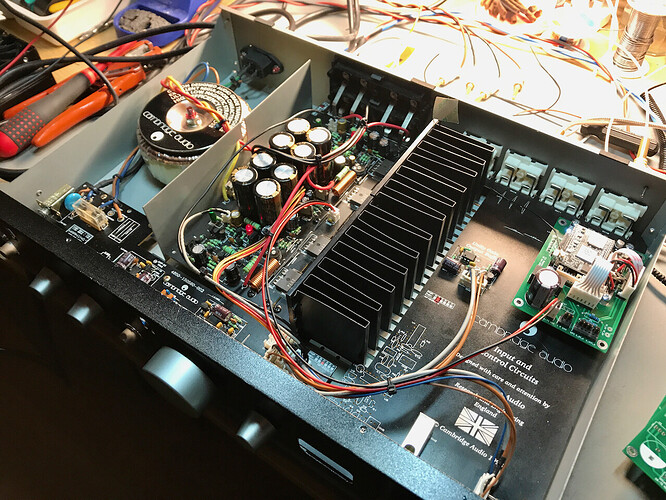With release 1.920 (located HERE), open loop testing is enabled. Recall open loop testing allows you to play a chirp on external hardware–typically hardware where you don’t have access to an input. But it’s also useful when you have Bluetooth available as an input. This post reviews the performance of a low-cost class D Bluetooth amplifier from Amazon located here.
The amp doesn’t rely on an transformer, but instead has an AC inlet in the back. The amp is rated for 300+300W, but as we’ll see, the amp isn’t able to deliver anywhere near that. For the test setup, we’ll use the typical QA401+QA451 connection diagram shown below. In the diagram, a QA450 is shown, but we’re using the QA451. Additional, since the amp is AC powered, we’re not using the QA451 current sensing.
Cabled Tests
Let’s first make some measurements to understand some general amp parameters. Starting with a -30 dBV into the amp, with the amp volume knob on max, we learn the aim gain is 32 dB with the EQ disabled (“High” knob turned fully CCW until it clicks). With the EQ enabled and flat, the gain drops to 23.3 dB. Unless noted below, the measurements below all reflect the EQ disabled and 32 dB of max input gain.
The output noise is -77 dBV (A Weighted, 20 to 20 kHz)
Using a log-sweep to learn the frequency response shows the following. Note that there is a load impedance sensitivity up around 10 to 20 kHz. The amp was clearly designed to be flat with an 8 ohm load, but when 4 ohm is used, your high end rolls off nearly 8 dB.
The low end has problems too, it that it appears to start rolling off around 400 Hz. At 20 kHz, the response is down 16 dB or so from the midband.
Finally, let’s take a look at the distortion versus output power into 4 ohms. Note the sharp knee around 100W. After hitting just shy of 100W, you can see the THD curve doubles back to the left. This means the power output collapsed and the distortion increased–the amp went into muting at this point. Most likely, the internal power supply on the amp ran out of gas and hit its current limit. The dead giveaway that something is up is that the outputs idle at 20V (relative to chassis ground), which means the internal supply is 40V. And assuming the class D part is push-pull, this means the load can be driven to +40Vp or -40Vp (28.4Vrms). This means best-case the amp should be able to hit 200W into 4 ohms–there’s no way it can hit 300W given the DC supply rail. And when the amp falters at 100W, since we know the rail should permit 200W, we can be certain that insufficient current is the culprit.
The amp also exhibits very strong microphonics, meaning you can hear the tone or sweep being played coming from inside the amp.
Bluetooth
Next, we can switch to Bluetooth. See the previous post on using the Open Loop mode on the QA401. Because we want to understand the frequency response of this amp, we’re going to switch to a 192K sample rate. We’ll use a WAV that was prepared as outlined in the previous post on the topic. To connect the Bluetooth, we insert a BT dongle into the PC, and tell Windows to connect to “BRZHIFI”.
Initially, the chirp wasn’t working. The problem is that the Bluetooth module used in the amp had a noise gate and would ramp up the sound. And the duration of the chirp was such that the chirp was mostly finished before the noise gate and fully released. The solution was simple: Just drag the chirp WAV to the right one second in Audigy. Then, when you press “play” you get a second of silence and that’s all it takes for the amp to begin its unmuting process. The chirp then plays normally after that second.
And the resulting spectrum plot is as follows for 48K. Note we can’t discern the impact of the QA401 response with the amp response, since the QA401 is in 48K sample rate.
We can repeat the experiment with the QA401 in 192K mode, ensuring that the rapid falloff we see at 20 kHz is due to the amp + Bluetooth and not the QA401.
Summary
The amp was advertised as a 300+300W amp. It failed to hit even 100W of power output, and exhibited some very poor qualities when facing overload. Too bad. As it is, the amp appears barely able to hit 19Vrms output into 4 ohms. But, it was another reasonable test point for Bluetooth open-loop testing, and unlike some other amps, this amp exhibited a noise gate that required some understanding to overcome.











